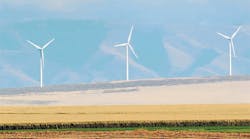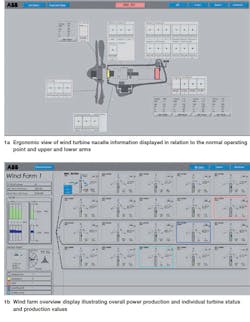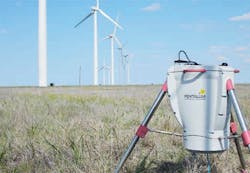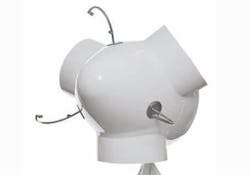As the power industry moves away from subsidized markets based upon feed-in tariffs and toward greater participation in the wholesale energy market and long-term power purchase agreements, today's technologies must enhance wind power generation within the competitive marketplace for renewable energy.
To do this, new technology is needed to facilitate optimized grid integration by improving the performance and reliability of wind turbine operation and reducing the cost of generation, and by improving production forecasting and power production management throughout the life cycle of a wind farm.
Understanding both the harsh environmental conditions in which wind turbines operate and the overwhelming demands placed on wind-farm operators is paramount to achieving the desired levels of improvement.
Consequently, modern control systems and new sensing devices must be developed to meet the specific and exacting requirements of the wind-farm operators. Automation control must have an intuitive human-machine interface (HMI), providing operators with timely access to the actual operating parameters and production data that will be used to ensure wind-farm production is optimized.
Market requirements
Using extensive experience gained from the successful operation of conventional power plants, ABB automation control systems can be harmonized for the optimized production from wind farms. The same supply challenges of flexibility and security of supply must be overcome. By ensuring that power quality is maintained through proper control systems, power production can be accurately forecasted and planned, and a power output to match system demand can be provided.
Grid codes
Electricity generators are required to comply with the stringent requirements of the network codes respective to each country of operation. These codes, also known as grid codes, specify the technical conditions and processes required for a generator's compliance with all aspects of planning, connection and operation.
The essential requirement of grid codes is to ensure wind power plants behave in a similar way to conventional power plants and provide the necessary grid support functions.
Modern control systems and new technologies have to support the challenges associated with grid integration and the contrasting variables in operating parameters required for grid-code compliance worldwide.
Beyond grid codes
ABB's automation system for the wind industry, Symphony Plus for Wind, has been configured to provide the control functionality required for grid-code compliance using bespoke control libraries implemented in a high-performance controller. This latest technology provides frequency containment by modulating active power and steady-state voltage control by changing reactive power. Importantly, by treating the wind farm as an integrated power plant, substation influence is also included in the system.
An optimized control system considers the capacity of each turbine to produce reactive power; checks the level of reactive power at the substation level; interfaces with the tap changer of the
main transformers to help regulate the voltage inside the wind farm; considers the voltage levels within the wind farm collector grid; and controls the reactive power resources to minimize losses in the collector grid to maintain voltage levels within the constraints.
Managing voltage and reactive power inside the wind farm reduces tripping risks and losses in the collector grids.
Unique automation systems
Symphony Plus for Wind automation has been uniquely developed to integrate wind turbine generation and electrical infrastructure (substations, capacitor banks, STATCOMs, etc.) into a single monitoring-and-control system for the power plant. The integration of the process power plant and the substation automation systems results in higher levels of availability, operator visibility and operational reliability.
Using standard protocols, such as IEC 61850, Modbus TCP and IEC 104, the number of control systems across a plant and the complexities associated with the engineering, installation and commissioning of individual control systems are reduced. Information can be seamlessly distributed to control room operators, maintenance engineers and plant engineers via a common database management system.
Having all assets integrated into a single control system is intrinsic to the optimization of wind power plant production.
Optimization of plant production
Generally, wind power plants have a faster response than conventional power plants. However, there are challenges mainly associated with the most significant variable – the availability of the wind energy and how this affects plant-production output levels. By continually monitoring both the individual output of each wind turbine and the cumulative output from the wind farm – collecting the large amounts of operating data, such as wind speed/direction and rotor speed, and interpreting this in line with production data, such as active/ reactive power – decisions can be made to ensure that each wind turbine, and the wind farm as a whole, is operating effectively and at optimal efficiency, modulating the output of the turbines to meet the required loads ➔ 1.
Overcoming wake effects in wind farms is an efficient and viable way to increase revenues from the wind turbines, as this can account for a few percent of power, depending on the wind farm layout, compared with non-wake, free-stream wind conditions. Optimizing the aerodynamic interaction between turbines is also critical for wind energy to gain advantage in the renewable energy market.
To maximize power production of the wind farm through wake effect optimization, Symphony Plus for Wind models the aerodynamic interaction between turbines, and calculates the effect of wake on electrical power output. Using a powerful online optimization engine, it then optimizes the active power of each turbine so that the power production from the entire plant is maximized and combined with the reactive power control in order to minimize overall losses in the collector grid.
New sensing devices
With its strategic investment in two companies – Pentalum Technologies and ROMO Wind – whose products have been designed to improve wind turbine performance and operations by measuring actual wind conditions more accurately, ABB is positioned to offer the latest technology in wind control systems. Integrating Pentalum's and ROMO Wind;'s technologies with Symphony Plus for Wind opens up the possibilities for the next level of wind turbines and wind farm controls.
Pentalum's innovative LIDAR (light detection and ranging) technology remotely senses the wind vector in front of wind turbines in order to optimally align the turbine with the incoming wind flow. Known as SpiDAR, the technology is also used for wind forecasting and site assessment, and is designed to significantly increase wind-farm efficiency at a lower cost per site than with other wind-vane measurement technologies, which less effectively sense air flow from behind the wind turbine.
SpiDAR also identifies wake effects and the compounded effect of turbulence. When integrated with Symphony Plus for Wind, the operator is provided with all of the relevant and timely information necessary to react appropriately to changing weather conditions that could seriously affect wind power plant operations ➔ 2.
ROMO Wind's iSpin technology provides accurate measurements of wind variables such as speed, direction and turbulence ➔ 3.
The combination of iSpin and Symphony Plus for Wind enables online and historical performance analysis of individual wind turbines on a wind farm, enabling operators to implement essential efficiency-improvement programs and consequently increase profitability. Yaw misalignment, rotor efficiency, maximum power-point-tracking effectiveness and accurate power curves can then be calculated and monitored in order to detect any underperformance of wind turbines. Dedicated software applications use iSpin and wind turbine data to define and report next-level key performance indicators for wind turbines, with the clear goal to maximize turbine performance.
Modern control systems
By integrating new sensing devices such as SpiDAR and iSpin, Symphony Plus for Wind can further optimize the production output of wind turbines and wind farms.
Using dedicated applications and realtime monitoring, the parameters measured by the field sensing devices are used to forecast and optimize power production output from the wind turbines and to determine the best energy prices. The field data is also used to provide diagnostics and prognostics of wind turbine operations, alerting the operators and maintenance personnel to any potential equipment malfunctions.
Symphony Plus for Wind has been developed with a hierarchical architecture for plant-level equipment and remote center systems using the proven technology S+ Operations. It can be used as a complete power management function, turning renewable plants into reliable generation.
Standardized communication protocols allow multiple power plants to be connected together, so that all relevant assets are interfaced with the other systems to become one centralized management system away from the geographical location of the remote power plants.
Ultimately, Symphony Plus for Wind provides an effective system platform that increases energy efficiency, improves engineering productivity and supports a more flexible and reliable plant operation and overall maintenance strategy.
Adrian Timbus
ABB Power Systems, Power Generation
Zurich, Switzerland
[email protected]





